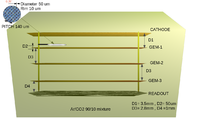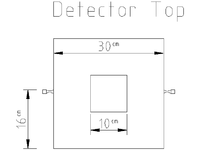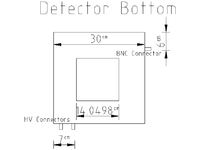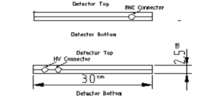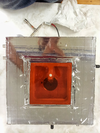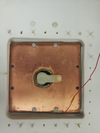Difference between revisions of "Detector Description"
| Line 6: | Line 6: | ||
==Detector Structure== | ==Detector Structure== | ||
| − | The triple GEM detector is based on three GEM preamplifiers, a cathode and an anode. | + | The triple GEM detector is based on three GEM preamplifiers, a cathode and an anode. A GEM preamplifier is 50 microns |
| + | thick kapton foil clad on both sides with 5 microns of copper. A staggered pattern of 50 microns diameter holes, equally spaced by distances comparable to the hole diameter, is chemically etched into the copper clad foil of an area of10x10cm <ref= Souli> F. Sauli, et al, NIM A 386, 531 (1997) </ref>, and has a 140 um pitch distance. The detector possesses three GEM cards in square plastic frames, they are placed parallel to the cathode and are separated by a vertical distance of 2.8 mm as shown in the figure below. | ||
[[File:GEM_Detector_original.png | thumb |alt=Example alt text|Fig.1 shows the original GEM detector design.| center | 200px]] | [[File:GEM_Detector_original.png | thumb |alt=Example alt text|Fig.1 shows the original GEM detector design.| center | 200px]] | ||
Revision as of 02:10, 5 November 2013
GEM Detector Design and Structure
The GEM preamplifier described in section XXXX was used to increase the signal amplitude of the ionization chamber. Primary electrons liberated by an ionizing particle within the ionization chamber that has a 90/10 Ar/CO2 gas, then the cathode's electric field accelerates them towards the GEM preamplifier. As described in section XXX, a single GEM preamplifier can increase the number of liberated electron by two orders of magnitude via secondary ionization[GEM amp reference]. Using three pre-amplifiers will increase the signal amplitude such that it is relatively more observable. A high voltage divider circuit is used to establish the electric fields at for each preamplifier using a single power supply channel, therefore secondary electrons are guided toward a segmented charge collector.
Detector Structure
The triple GEM detector is based on three GEM preamplifiers, a cathode and an anode. A GEM preamplifier is 50 microns thick kapton foil clad on both sides with 5 microns of copper. A staggered pattern of 50 microns diameter holes, equally spaced by distances comparable to the hole diameter, is chemically etched into the copper clad foil of an area of10x10cm <ref= Souli> F. Sauli, et al, NIM A 386, 531 (1997) </ref>, and has a 140 um pitch distance. The detector possesses three GEM cards in square plastic frames, they are placed parallel to the cathode and are separated by a vertical distance of 2.8 mm as shown in the figure below.
The cathode is a square copper plate that is a 10x10cm and has a distance of 3.5 mm from the top of the first GEM card. This cathode design allows a rise in potential on its surface up to 5 kV (in the air) without any discharge effect.The charge collector (readout anode) is constructed of 50-80 micron wide strips and are insulated to determine the location of the collected electrons. They are arranged to give equal charge sharing on the charge collector.
All the previous components exist in a sealed chamber that consists of two ertalyte plastic sheets; they are bolted together by a number of M3 plastic screws located around the detector window to form a well enclosed cavity. Also, the chamber has a 13x13cm kapton window for incident particles.The figures below show top, bottom and side view of the detector's chamber design.
Modifying the GEM detector as neutron sensitive detector
The GEM’s original design was modified to convert it to a neutron sensitive detector. As mentioned previously in the induced fission fragment section, the existence of a fissionable material is important to detect the neutron signal by detecting the ionization of one of the fission fragments. Therefore, the cathode design has a 3 cm diameter coating of U-233, and 30-40 um thickness. The kepton window had an increase in height of 2.5 mm, which helped to increase the distance of the cathode to 8 mm from the top of the first of GEM card (instead of 3.5 mm in the original design). An FR4 shutter was attached in the space between the cathode and the first GEM card, which had enough area to cover the coating area; it has a position controller that helps to open and close the shutter. When the shutter is closed, it covers the U-233 coating and stops the emitted fission fragments from causing ionization in the gas, but when the shutter is open, the ionization of the fission fragments produces a signal that indicates the existence of neutrons inside the chamber which the detector trigger detects for analysis by the DAQ system.
The figures below show the modified components of the detector.
High voltage divider circuit
The GEM preamplifiers are connected with high voltage divider circuit that determines the electron multiplication and transfer to the readout plate. The GEM cards are connected to the high voltage divider circuit that is shown in the figure below:

It provides the cathode with a voltage of 3.6 kV, and it produces an electric field which drifts most of the electrons that are primarily produced by ionization. The circuit also provides the GEM preamplifiers with voltage between the top and bottom of each card; the voltage gradually decreases to have the least value between the sides of the third GEM card. This design's advantage is to provide enough voltage for electron multiplication, and to guide most of the drift electrons to the grounded readout plate.
The following table shows the voltage measurements between the sides of the GEM preamplifiers, and voltage between each side and the ground using the HV-voltage divider circuit shown in figure (2).
| 2550 | 2579 | 2259 | 304 | 1671 | 1394 | 279 | 818 | 570 | 245 |
| 2600 | 2630 | 2303 | 310 | 1704 | 1421 | 285 | 834 | 581 | 250 |
| 2650 | 2680 | 2348 | 316 | 1737 | 1449 | 290 | 850 | 592 | 255 |
| 2700 | 2731 | 2393 | 322 | 1770 | 1476 | 296 | 866 | 603 | 260 |
| 2750 | 2781 | 2373 | 328 | 1803 | 1503 | 302 | 882 | 614 | 264 |
| 2800 | 2832 | 2482 | 332 | 1836 | 1530 | 307 | 898 | 625 | 269 |
<references/>
Go Back [1]
